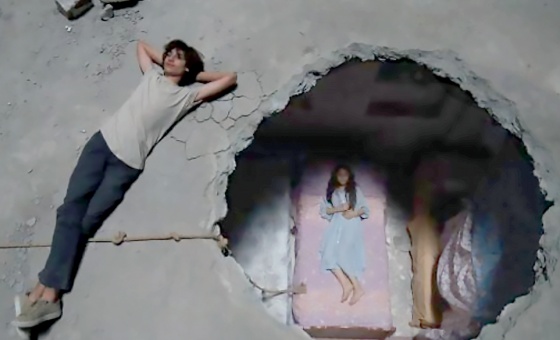This is the last article you can read this month
You can read more article this month
You can read more articles this month
Sorry your limit is up for this month
Reset on:
Please help support the Morning Star by subscribing here
R B Kitaj
Piano Nobile, London
AN outsider, who would forever define himself as such, R B Kitaj was born in 1932 in Cleveland, Ohio as Ronald Brooks. The following year his Hungarian father left his Jewish-American mother Jean, and she reared her child alone while working as a secretary and as a school teacher.
In 1941 she married Dr Walter Kitaj, a Viennese Jew and her son adopted his stepfather’s surname. The family moved to Troy, upstate New York in 1942 and by 1950 the young Kitaj escaped small-town life to become a sailor on cargo ships until 1954, during which time he read avidly.
Thus began what would remain an enduring and restless quest for adventure, learning and travel, all the while drawing and reading avidly.
Kitaj soon self-exiled to Europe where he travelled widely before settling in England where he studied at the Ruskin School of Drawing and Fine Art, Oxford (1958-9) and at the Royal College of Art (RCA) (1960-2). There he met Derek Boshier, Allen Jones and especially David Hockney who became a lifelong friend.
They both rebelled against the prevailing aesthetic which was still indebted to the concept of form over content and to progressing to ever more “advanced” styles, rather than focusing on subject matter and its meanings. By then, this privileged abstraction above all else, so that Kitaj’s and Hockney’s adherence to meaningful figuration appeared to be a regression to traditional art.
Going even further against the grain, Kitaj turned to history painting, the 19th-century genre most reviled by the 20th-century avant-garde. But far from producing outdated works Kitaj adopted Ezra Pound’s dictum “Make It New”. And he did.
The Murder of Rosa Luxemburg of 1960, painted in his first year at the RCA, combines collage, painting and drawing in an emotive statement about Luxemburg’s body being thrown in the river. Scattered across the canvas are images of a pyramid, a monument, a classical statue, a drawing of a man’s profile and a sheet of paper neatly typed which seems to be mostly concerned with Kitaj’s Jewish grandmothers.
The work defies attempts to understand the links between all these diverse references, and mystery would increasingly characterise Kitaj’s future works, while direct references to socialist politics soon ceased.
“There will always be pictures whose complexity, difficulty, mystery will be ambitious enough to resemble the patterns of human existence,” he wrote, and this sums up his own work, whose content deliberately defies univalent interpretations. Enigmatic, layered meanings, references to history, world literature, culture, sex and his personal relationships appear in the paintings and in their titles.
Synchromy with FB — General of Hot Desire (1968-9), for example, features a three-quarter-length portrait of Francis Bacon, a half-length woman, an American landscape with covered bridge and a grumpy Native American Indian.
References abound to his mixed American and European sensibilities, his long stays in London, England and his travels in France, Spain, Austria and North Africa, and to his beloved wife Sandra who died tragically in 1969.
His secular Jewish identity preoccupied him in his late works. He said: “In a way, I’m interested more in content than ever in my embattled attempt to forge a personal Jewish art,” and “I would rather find the energy to do for Jews what Morandi did for jars.”
He was uneasily and incorrectly placed within Pop Art at the time, probably because of the “return” to figuration in the early 1960s and his use of flat areas of colour. But ultimately his work had little in common with the likes of David Hockney, Roy Lichtenstein, et al.
The content of Kitaj’s work was accused of being pretentious, portentous or over intellectualised, especially by British critics, while others were simply baffled. Yet his work was represented by a prestigious London commercial gallery early in his career and he had many solo exhibitions in museums.
His superb skills as a fluid, expressive draughtsman and bold colourist, and his square or narrow compositions, enabled him to surprise and seduce the viewer into engaging with such complex works, while their scale echoes that of human beings.
Like the archetypal wandering Jew, Kitaj devoted his life to grappling with his conflicted understanding of the world and to finding a place within it. He wrote that he seemed “to belong, now, to England and to London after all these years... but I can say without hesitation that I don’t fit in here and never will in any profound way. I’ve noticed that some exiles do (become very English) and Some Do Not! I won’t name names! The Jewish Thing (sic) is so complex... it will have tempered everything for me... the life, the art, the American times, the English passage. Maybe it is the Jewishness, its recognitions and histories which will separate my English life from the lives of, say, Henry James, Eliot, Sargent, Whistler...
“Proust said all masterpieces are produced by neurotics, so there’s some hope for me yet.”
The free exhibition offers works in various media ranging across Kitaj’s entire career and their domestic scale suits the gallery’s intimate spaces. It provides a rare opportunity to see many originals in London.
R B Kitaj runs until January 26 2024, admission free. For more information see: piano-nobile.com













